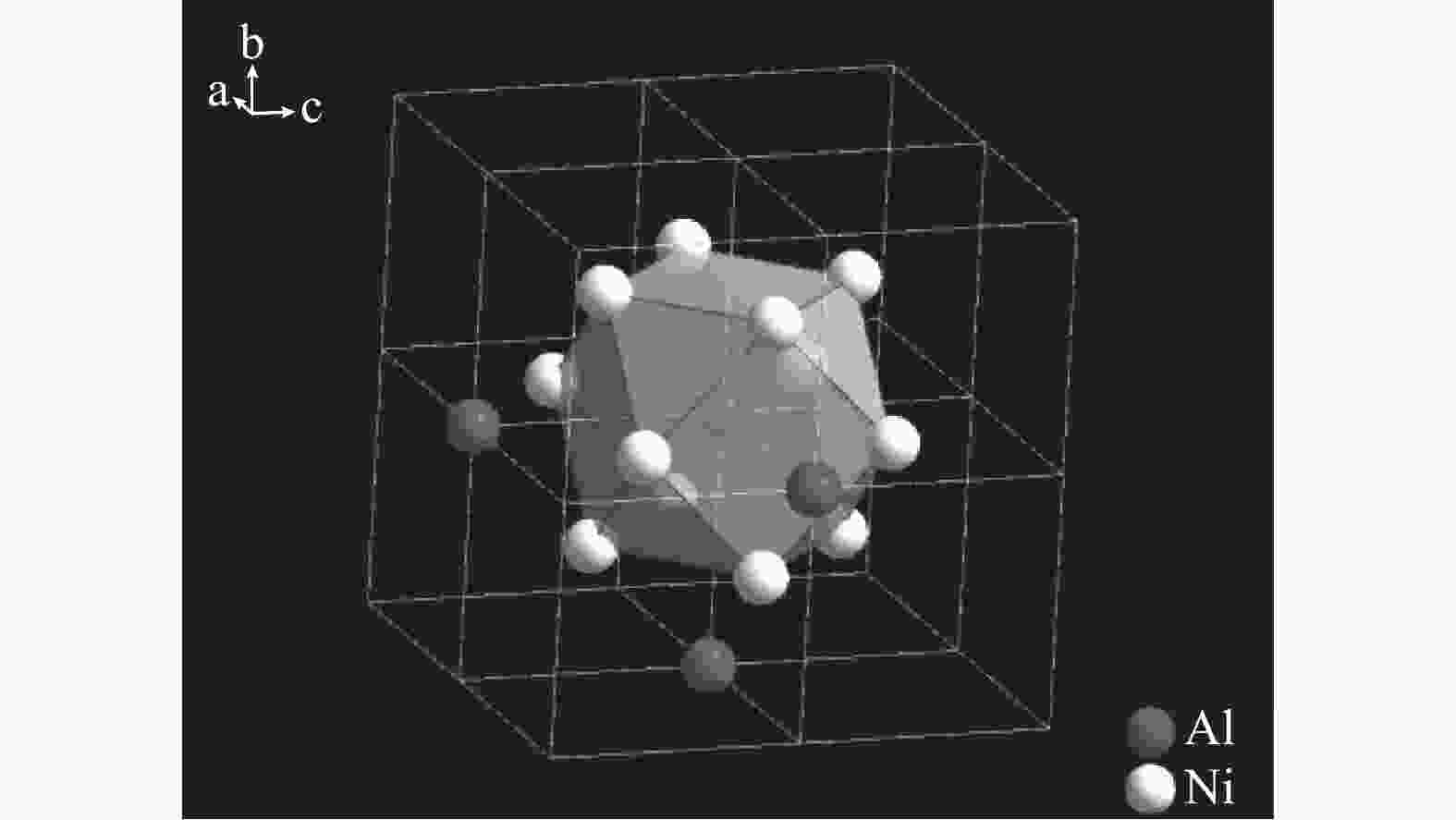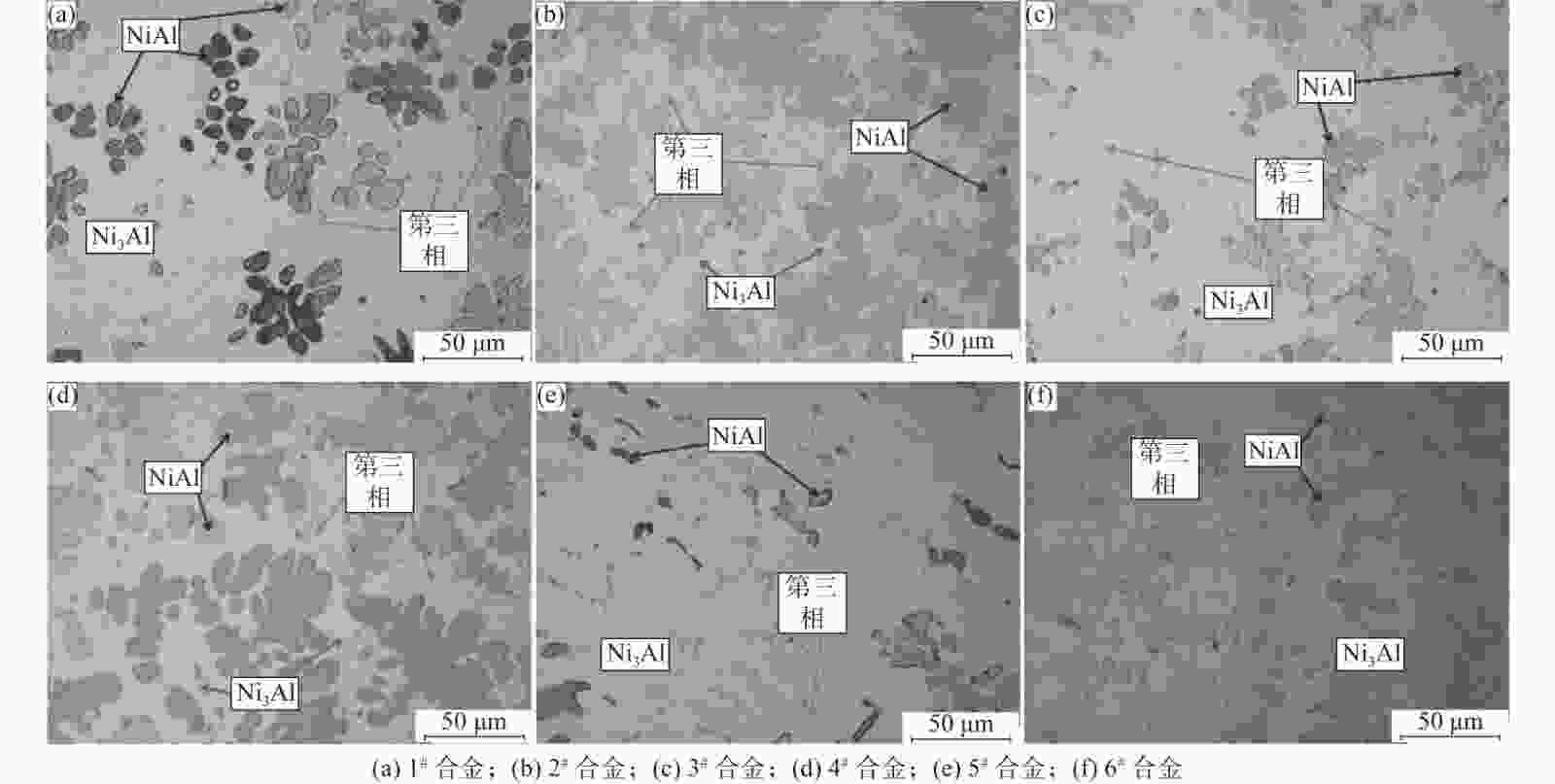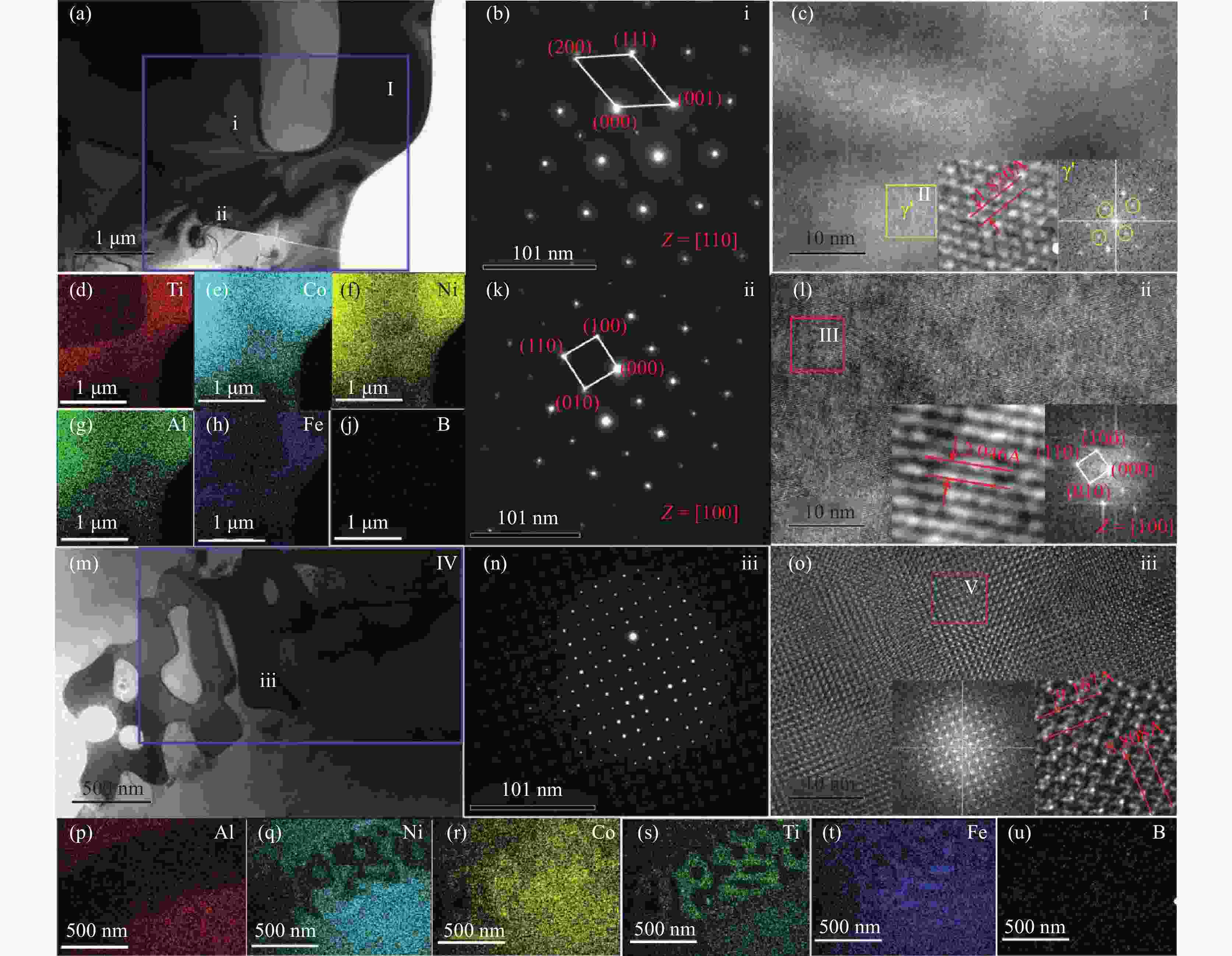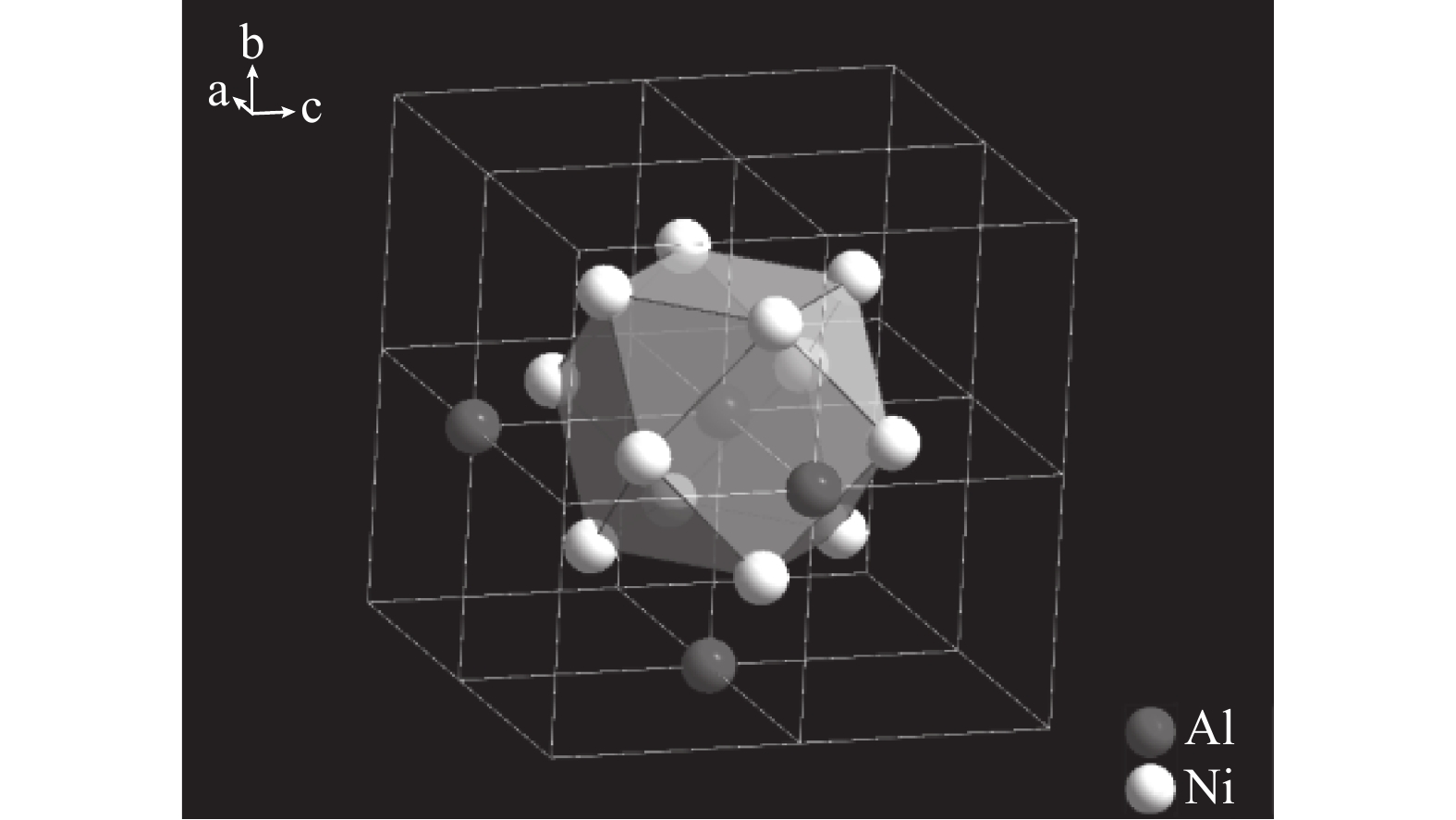Microstructure and mechanical properties of Ni3Al based intermetallic designed based on 'cluster plus connected atom' model
-
摘要: Ni3Al金属间化合物的室温脆性问题极大地限制了其应用。通过“团簇加连接原子”模型对Ni3Al金属间化合物进行成分和结构解析及成分设计,通过Co、Fe部分取代团簇壳层上的Ni,Ti部分取代连接原子Al,设计出六种合金。并对其显微组织及力学性能进行了表征。结果表明:六种合金的显微组织均由Ni3Al相(γ′相)、NiAl相(BCC)和少量共晶析出的第三相所构成,且通过TEM分析证实了基体为Ni3Al相。相比于Ni3Al金属间化合物,合金的室温强度、硬度和塑性均有大幅度的提升。分析其原因是由于基体为Ni3Al相,保持了合金基体的强度和硬度,当Ni3Al基体中析出少量的BCC相时,进一步提高合金的强度和硬度,而当BCC含量过高时,合金的强度和硬度降低,塑性升高。
-
关键词:
- Ni3Al金属间化合物 /
- "团簇加连接原子"模型 /
- 相分析 /
- 力学性能
Abstract: The room temperature brittleness of Ni3Al intermetallic compounds significantly limits its application. Accordingly, in this paper, the composition and structure of Ni3Al intermetallic compounds are analyzed, and the composition is designed by the 'cluster plus connected atom' model. Six alloys were designed by replacing some Ni on the cluster shell with Co and Fe and replacing some connecting atom Al with Ti. Simultaneously the microstructure and mechanical properties of these alloys were characterized. The results show that the microstructures of all six alloys are composed of the Ni3Al phase (γ′ phase), NiAl phase (BCC), and a small amount of eutectic precipitated third phase, and the formation of the Ni3Al phase is confirmed by TEM analysis. The alloy designed in this paper has improved room temperature strength, hardness, and plasticity compared to the Ni3Al intermetallic compound. The reason is that the formation of the Ni3Al phase as the matrix improves the strength and hardness. When a small amount of BCC phase precipitates in the Ni3Al matrix, it helps further to improve the strength and hardness of the alloy. In comparison, the high concentration of BCC decreased the strength and hardness and increased the plasticity. -
图 5 1#合金在不同区域的明场相(a和m),位置i和ii和iii的选区电子衍射花样(b,k,n),位置i的高分辨图像以及在图中区域Ⅱ傅里叶变化图像(c),位置ii的高分辨图像以及在图中Ⅲ区域的傅里叶变化图像(l),位置iii的高分辨图像以及在图中Ⅴ区域的傅里叶变化图像(o),Ⅰ区域的成分分布(d~j),区域Ⅳ成分分布(p~u)
Figure 5. The bright field phase (a and m) of 1# alloy in different regions, the selected area electron diffraction pattern (b, k, n) of positions i and ii and iii, the high-resolution image of position i and the FFT image (c) of region II in the figure, the high-resolution image of position ii and the FFT image (l) of region III in the figure, the high-resolution image of position iii and the FFT image (o) of region V in the figure, and the composition distribution (d-J) of the region I, regional IV component distribution (p-u)
表 2 各合金的实际化学成分组成
Table 2. Actual chemical compositions of each alloy
% 合金 Ni Co Fe Al Ti 1# 41.535 33.998 6.14 6.666 11.661 2# 42.519 35.496 6.331 10.099 5.555 3# 47.751 27.994 6.835 6.409 11.011 4# 49.099 28.429 6.502 10.084 5.886 5# 54.601 21.197 6.371 6.36 11.471 6# 56.407 21.356 6.468 9.97 5.799 表 1 基于团簇加连接原子模型设计的合金成分
Table 1. Alloy composition list based on cluster plus linked atom model
合金 原子替换 原子百分比/% 加B后的原子百分比/% 加B后的质量百分比/% 1# [Al-(Ni6-Co5-Fe)]AlTi2 Ni37.5Co31.25Fe6.25Al12.5Ti12.5 (Ni37.5Co31.25Fe6.25Al12.5Ti12.5)98B2 Ni41.2Co34.4Fe6.5Al6.3Ti11.2B0.4 2# [Al-(Ni6-Co5-Fe)]Al2Ti Ni37.5Co31.25Fe6.25Al18.75Ti6.2 (Ni37.5Co31.25Fe6.25Al18.75Ti6.25)98B Ni42.2Co35.3Fe6.7Al9.7Ti5.7B0.4 3# [Al-(Ni7-Co4-Fe)]AlTi2 Ni43.75Co25Fe6.25Al12.5Ti12.5 (Ni43.75Co25Fe6.25Al12.5Ti12.5)98B2 Ni48Co27.6Fe6.5Al6.3Ti11.2B0.4 4# [Al-(Ni7-Co4-Fe)]Al2Ti Ni43.75Co25Fe6.25Al18.75Ti6.25 (Ni43.75Co25Fe6.25Al18.75Ti6.25)98B2 Ni49.2Co28.3Fe6.7Al9.7Ti5.7B0.4 5# [Al-(Ni8-Co3-Fe)]AlTi2 Ni50Co18.75Fe6.25Al12.5Ti12.5 (Ni50Co18.75Fe6.25Al12.5Ti12.5)98B2 Ni54.9Co20.7Fe6.5Al6.3Ti11.2B0.4 6# [Al-(Ni8-Co3-Fe)]Al2Ti Ni50Co18.75Fe6.25Al18.75Ti6.25 (Ni50Co18.75Fe6.25Al18.75Ti6.25)98B2 Ni56.3Co21.2Fe6.7Al9.7Ti5.7B0.4 表 3 合金各相所占体积分数
Table 3. Volume fraction of each phase in the alloy
合金 体积分数/% NiAl相 Ni3Al相 第三相 1# 29 65 6 2# 46 50 4 3# 27 68 5 4# 44 52 4 5# 8 88 4 6# 42 54 4 表 4 合金的显微硬度
Table 4. Microhardness of alloy
合金 显微硬度(HV) 屈服强度/MPa 最大压缩率/% 1# 558 1350 29 2# 500 1200 30 3# 528 1250 34 4# 484 1050 35 5# 508 1100 37 6# 470 900 37 -
[1] Xu Songbo. A new generation of high temperature structural material-intermetallic compound Ni3Al[J]. Shanghai Nonferrous Metals, 1997,(2):88−92. (徐颂波. 新一代高温结构材料──金属间化合物Ni3Al[J]. 上海有色金属, 1997,(2):88−92. [2] Gong Shengkai, Shang Yong, Zhang Ji, et al. Research progress and application of typical intermetallic based high temperature structural materials in China[J]. Acta Metallurgical Sinica, 2019,55(9):1067−1076. (宫声凯, 尚勇, 张继, 等. 我国典型金属间化合物基高温结构材料的研究进展与应用[J]. 金属学报, 2019,55(9):1067−1076. doi: 10.11900/0412.1961.2019.00148 [3] Sauthoff G. Physical metallurgy and processing of intermetallic compounds[M]. Stoloff N S, Sikka V K. London: Chapman & Hall, 1997. [4] Aoki K. Ductilization of L12 intermetallic compound Ni3Al by microalloying with boron[J]. Materials Transactions, 1990,31(6):443−448. doi: 10.2320/matertrans1989.31.443 [5] Orban R L, Lucaci M. Effect of small iron, chromium and boron additions as alloying elements on microstructure and mechanical properties of Ni3Al[J]. Advanced Materials Research, 2007,23:123−126. doi: 10.4028/www.scientific.net/AMR.23.123 [6] Lapshin O, Savitskii A, Ovcharenkon V. Mathematical model of Ni3Al compound synthesis from powder mixture under pressure[J]. Journal of Materials Synthesis and Processing, 2002,10(5):257−261. doi: 10.1023/A:1023042109294 [7] Yang T, Zhao Y L, Li W P, et al. Ultrahigh-strength and ductile superlattice alloys with nanoscale disordered interfaces[J]. Science, 2020,369(6502):427−432. doi: 10.1126/science.abb6830 [8] Dong C, Wang Q, Qiang J B, et al. From clusters to phase diagrams: composition rules of quasicrystals and bulk metallic glasses[J]. Journal of Physics D:Applied Physics, 2007,40(15):273−291. doi: 10.1088/0022-3727/40/15/R01 [9] Chen H, Wang Q, Wang Y, et al. Composition rule for Al–transition metal binary quasicrystals[J]. Philosophical Magazine, 2010,90(30):3935−3946. doi: 10.1080/14786435.2010.502144 [10] Chen H, Qiang J, Wang Q, et al. A cluster-resonance criterion for Al-TM quasicrystal compositions[J]. Israel Journal of Chemistry, 2011,51(11-12):1226−1234. doi: 10.1002/ijch.201100139 [11] Wang Z, Dong D, Qiang J, et al. Ti-based glassy alloys in Ti-Cu-Zr-Sn system[J]. Science China Physics, Mechanics and Astronomy, 2013,56(7):1419−1422. doi: 10.1007/s11433-013-5104-7 [12] Wang Y, Wang Q, Zhao J, et al. Ni–Ta binary bulk metallic glasses[J]. Scripta Materialia, 2010,63(2):178−180. doi: 10.1016/j.scriptamat.2010.03.044 [13] Zhu C L, Wang Q, Li F W, et al. Cluster-based bulk metallic glass formation in Fe-Si-B-Nb alloy systems[J]. Journal of Physics:Conference Series, 2009,144:012048. doi: 10.1088/1742-6596/144/1/012048 [14] Wang Q, Li Q, Li X, et al. Microstructures and stability origins of β-(Ti, Zr)-(Mo, Sn)-Nb alloys with low young's modulus[J]. Metallurgical and Materials Transactions A, 2015,46(9):3924−3931. doi: 10.1007/s11661-015-3011-4 [15] Ma Rentao, Hao Chuanpu, Wang Qing, et al. "Cluster plus connected atom" model and composition design of Ti-Mo-Nb-Zr solid solution alloy with low elastic bcc structure[J]. Acta Metallurgical Sinica, 2010,46(9):1034−1040. (马仁涛, 郝传璞, 王清, 等. 低弹bcc结构Ti-Mo-Nb-Zr固溶体合金的“团簇+连接原子”模型及其成分设计[J]. 金属学报, 2010,46(9):1034−1040. doi: 10.3724/SP.J.1037.2010.00039 [16] Zha Qianfeng, Liu Enxue, Dong Chuang, et al. Composition design of high strength martensitic precipitation hardening stainless steel based on cluster model[J]. Acta Metallurgical Sinica, 2012,48(10):1201−1206. (查钱锋, 刘恩雪, 董闯, 等. 基于团簇模型的高强度马氏体沉淀硬化不锈钢成分设计[J]. 金属学报, 2012,48(10):1201−1206. doi: 10.3724/SP.J.1037.2012.00053 [17] Dong D, Zhang S, Wang Z, et al. Nearest-neighbor coordination polyhedral clusters in metallic phases defined using Friedel oscillation and atomic dense packing[J]. Journal of Applied Crystallography, 2015,48(6):2002−2005. doi: 10.1107/S1600576715018920 [18] Zhang J, Wang Q, Wang Y, et al. Revelation of solid solubility limit Fe/Ni = 1/12 in corrosion resistant Cu-Ni alloys and relevant cluster model[J]. Journal of Materials Research, 2010,25(2):328−336. doi: 10.1557/JMR.2010.0041 [19] Ding J, Jiang S, Li Y, et al. Microstructure evolution behavior of Ni3Al (γ′) phase in eutectic γ-γ′ of Ni3Al-based alloy[J]. Intermetallics, 2018,98:28−33. doi: 10.1016/j.intermet.2018.04.010 [20] Wang W R, Wang W L, Yeh J W. Phases, microstructure and mechanical properties of AlxCoCrFeNi high-entropy alloys at elevated temperatures[J]. Journal of Alloys and Compounds, 2014,589:143−152. doi: 10.1016/j.jallcom.2013.11.084 [21] Wrwa B, Wlw B, Scw B, et al. Effects of Al addition on the microstructure and mechanical property of AlxCoCrFeNi high-entropy alloys[J]. Intermetallics, 2012,26:44−51. doi: 10.1016/j.intermet.2012.03.005 [22] Rao J C, Diao H Y, Ocelík V. et al. Secondary phases in AlxCoCrFeNi high-entropy alloys: An in-situ TEM heating study and thermodynamic appraisal[J]. Acta Materialia, 2017,131:206−220. doi: 10.1016/j.actamat.2017.03.066 -





 下载:
下载:








